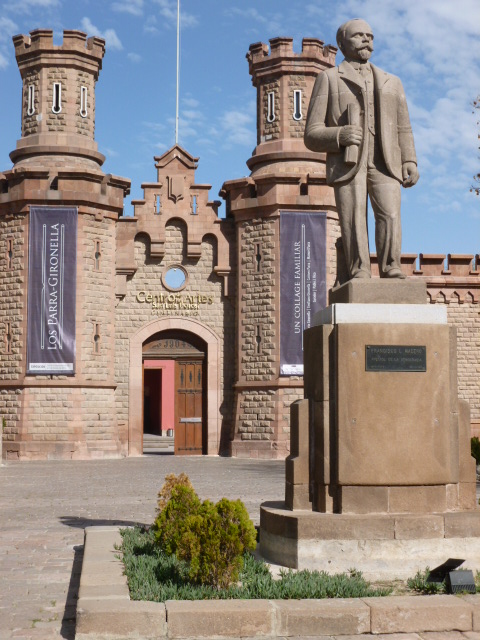“The Hilly Place of Frogs”
Posted by erasingborders

Former State Prison Now a Center for the Arts in San Luis Potosi. Franciso Madero, once a prisoner here, stands in front of the Arts Center
A nearly week long visit of older brother Fred and wife Mary enabled Doug to visit some of San Luis Potosi’s many museums while Kate continued her Spanish classes. One of the museums fascinated Mary in particular. Having spent a year researching life in a prison in their home state of Minnesota, Mary was moved and quite impressed by the State of San Luis Potosi turning their largest prison into a museum and center for the arts. But let them speak for themselves. Here’s Fred’s description of the highlights of our San Luis Potosi touring:
“The colonial part of San Luis is wonderfully preserved with large cobblestoned but narrow streets, many of which are reserved for pedestrians. One particularly impressive and moving visit was to a nineteenth century prison built around a central courtyard like the spokes of a wheel. The government has recently turned the prison into a community center for the arts with different areas devoted to painting, sculpture, dance, music…. In the center was a huge American flag with dollar signs and death heads instead of stars.”
Following their too brief visit with us in San Luis, we traveled together to Guanajuato. Kate and I had heard rave reviews of this city’s attractions so we were delighted to discover “the hilly place of frogs” with Fred and Mary. On the way, we admired the central plaza and ate in Dolores Hidalgo, where Mexico’s struggle for independence from Spain began on September 16, 1810. On that date Father Miguel Hidalgo issued the cry (“grito) for freedom to residents of Dolores before marching on Guanajuato.
Why they marched on Guanajuato is suggested by Fred’s notes on our visit there. He wrote the following to friends and family: ”According to our guide book, for 250 years from 1558 on, one mine on the outskirts of the present Guanajuato produced 20 percent of the world’s silver. One of the old haciendas, with eighteen formal gardens (Roman, Japanese, Mexican, etc.), we saw Sunday, put even the grand, agriculturally-based haciendas of the Yucatan to shame. We didn’t get to see Guanajuato’s “museum of the sacred inquisition” nor its museum of the mummies (the latter possible because the water is so minerally ladened that cadavers of life-long inhabitants of the area are naturally preserved). Those who have led most interesting lives evidently end up as displays in the mummy museum. After having visited on our way to Guanajuato an artisania (in Dolores Hidalgo, notes Doug) that made 5 feet high ceramic statues of female skeletons in all kinds of garb and dramatic poses, all with identically compelling grins, it was hard to pass up the mummy museum but we did and visited the Diego Rivera house and museum instead. Amazing.”
After centuries of mining and building of flood control tunnels in Guanajuato’s canyon, few traces of its pre- Hispanic past remain. Frogs are now scarce. But the city’s name, “the hilly place of frogs”, which comes from the “P’urhepecha” Amerindian language, is preserved.
Looking up the derivation of Guanajuato’s name led to some other discoveries. According to Wikipedia, “The government of Mexico recognizes 68 distinct indigenous Amerindian languages as national languages in addition to Spanish.” Furthermore, while Spanish is the language spoken by the vast majority of Mexicans, it is not recognized as the “official” language of the country. The 1917 Constitution commits the nation to preserving the status of the country’s “indigenous” languages. While fewer than ten per cent of the Mexican population now speak an “indigenous” language, the Constitution advocates support of “bilingual” and “bicultural” education.
For photos of Dolores Hidalgo and Guanajuato, go to the album at:
https://plus.google.com/u/0/photos/105354530047201453343/albums/5836354290753690385
Click on the Slide Show tab on the right above the photos to enlarge the photos and see accompanying comments.
.
About erasingborders
This blog is dedicated to the conviction that love is stronger than hate, that trained non violent resistance is stronger than weapons of violence and that as human beings we rise and we fall as one people.Posted on January 30, 2013, in Uncategorized and tagged Dolores Hidalgo, Guanajuato's Ex Hacienda San Gabriel de Barrera, San Luis Potosi's Centro de Artes. Bookmark the permalink. 3 Comments.

Thanks, Doug, this is so interesting especially since Geroge’s kids grew up in Guanajuato. Glad Fred and Mary could spend time with you and that you got to see the sights with them. Love you, Obama Mama
LikeLike
Pastor Kate, just thought you’d be interested ……. today Bonita Luts came to visit Rhonda and she left a note saying how much she & Barbara Miller have enjoyed your info from the emails. I have been printing them & giving them to Barbara and she has passed onto Bonita and circulated among all who were interested. Rhonda has enjoyed them too. Sincerely, Carol (Rhonda’s friend)
LikeLike
Thank you Carol! I am so appreciative of your help in letting our friends know of our blog postings. You are a wonder! So happy that Rhonda and all have enjoyed the posts, thanks to you! Give Rhonda my greetings, please. I received a lovely lettter from Glenna (her Christmas letter) and thanks to Rhonda for sending her our information! Hope you are having a good 2013! Your sister in Christ, Kate
LikeLike